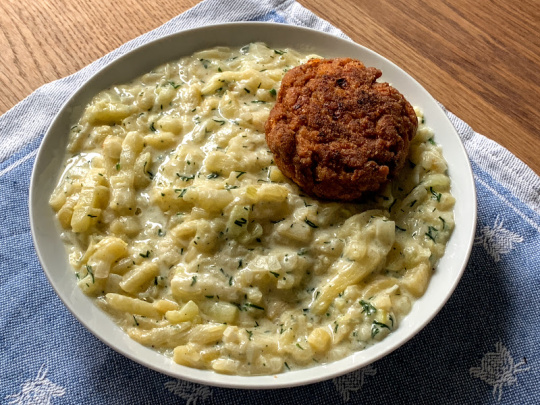
One of Hungary’s most commonly eaten vegetable stews draws both avid admirers and staunch detractors. Thickened with sour cream, spiked with fresh dill, and topped with a meatball, the tökfőzelék is a reviving summer dish. Some people refrigerate the tökfőzelék and serve it chilled.
Ingredients
Yield: 4-5 servings; Total time: 45 minutes
For the squash stew
2 kilos (4 ½ pounds) fresh summer squash, peeled, seeded, and cut into matchsticks using a mandoline or a chef’s knife or 1 ½ kilos (3 pounds) frozen and julienned summer squash
3 tablespoons butter or oil, for the pan
1 onion, peeled and minced
2 cloves garlic, peeled and minced or mashed
2 teaspoons salt (more to taste)
3 pinches ground black pepper
250 grams (1 cup) cup sour cream
1 tablespoon flour
2 tablespoons butter, to finish
2 bunches fresh dill, finely chopped
Crusty bread for the side
Directions
Step 1: Prepare the vegetable stew. Heat butter or oil in a large pot over medium-high, then add minced onion and sauté until translucent, about 5-7 minutes. Add garlic and sauté for another minute, stirring constantly so garlic doesn't burn.
Step 2: Add squash, then season with salt and pepper. With the lid on, steam-cook the squash at a low simmer until soft but still with a bit of bite left to it, about 10-15 minutes (no need to add liquid as it will release enough).
Step 3: In a medium bowl, mix together sour cream and flour and pour the mixture over the stew. Let the sauce thicken into a creamy consistency at a low simmer for 2-3 minutes. Remove pot from heat, add butter and finely chopped dill and mix well.
Step 4: Taste summer squash stew for salt and add more if needed. Serve in shallow bowls topped with one or two meatballs and crusty bread on the side.
Words of advice
The amount of chopped dill used here can make a big difference. Use a generous hand and you won't regret it, I promise.
I created these recipes with the help of nearly a dozen historical Hungarian cookbooks, adjusting ingredients, cooking times, and methods to reflect my own preferences and tastes of the current day. Do you have any feedback? Please let me know!